- Home
- Technology
- Ricoh's Technology
- Multi-spectroscopic Camera
Multi-spectroscopic Camera
Ricoh has developed a multi-spectroscopic camera that can acquire 2D spectral information as well as chromaticity and other color information for a subject in real-time. And it’s all packaged in a unique configuration similar in size to an ordinary FA camera.
Multi-spectroscopic camera features
A multi-spectroscopic camera can acquire spectral information from a subject. Although systems using swappable color filters and prisms have been established as normal techniques for acquiring spectral information, with interchangeable color filters time to swap poses a barrier to real-time imaging. On the other hand, with prisms, it is difficult to make the camera more compact.
Ricoh multi-spectroscopic cameras use optical devices that can acquire plural spectral information in a single snapshot, together with image processing technology that generates an image for each spectral information. As a result, spectral distribution and chromaticity for particular wavelengths can be computed in real-time. This makes it possible to precisely acquire the desired spectral information. In addition, spectral information can be acquired with a device similar in size to a conventional factory automation (FA) camera. Beyond detecting subjects hard to distinguish from each other, our multi-spectroscopic cameras can be used to inspect objects whose states change over time and detect foreign matter. In addition to FA, possible applications include the food, pharmaceutical, agricultural, and security industries.
Technology overview
The new multi-spectroscopic cameras developed by Ricoh incorporate the following three technologies:
- A color filter that extracts plural spectral information from an object
- A microlens array that distributes the plural spectral information onto sensor pixels
- An image processor that generates an image for each spectral information from the sensor image
Spectra and chromaticity are then computed from the plural spectral information obtained in this way (see Figure 1).
In a Ricoh multi-spectroscopic camera, light from one object point passes through the filter having different spectral characteristics, and each light makes an image in a different position on the sensor. This makes it possible to obtain a two-dimensional spectral image in a single shot. Fusion of the optical and image processing technology of Ricoh enabled plural spectral information to be acquired two-dimensionally and in a single shot.

Figure 1: Multi-spectroscopic camera configuration
Types of multi-spectroscopic camera
Multi-spectroscopic cameras can be used as 1) multispectral camera, 2) 2D color analyzer, and 3) multiband camera, according to the characteristics of the spectral filter.
1) Multispectral cameras can obtain continuous spectral information (such as luminescence emission spectrum and spectral reflectivity) of the subject by using a spectral filter having continuous wavelengths.
2) A 2D (two-dimensional) color analyzer can extract accurate color information of the subject by using a spectral filter having sensitivity same as the human eye. The 2D color analyzer has merits compared to the ordinary RGB color camera on that the analyzer can sense colors exactly the human sees and that colors can be managed by chromaticity which is defined by the international standard.
3) A multiband camera can spectrally analyze the specified wavelengths according to application. By specifying the band beforehand, the camera can be customized.
Multi-spectroscopic camera applications
Multispectral camera and 2D color analyzer
Usage scenario: color inspection
By computing chromaticity, it becomes possible to conduct high-precision color inspections that outperform previous color photograph imaging inspections in which certain color determinations are impossible.
This technology can be used for color inspections of LCD, OLED, or other light-emitting displays. By using conventional point color checker, shooting and measurement need to be executed a plurality of times to check the entire screen. In contrast to this, you can carry out a color inspection of a display with only 1 shot with a multispectral camera or a 2D color analyzer (see Figure 2A, 2B). Regarding the multispectral camera, you can also check the light-emitting property of the display from the measured spectrum distribution chart (Figure 2C) at a time.
This technology can also be used for color inspections of molded or painted products with color limit samples (see Figure 4). Up to now, you needed to check physical objects and color limit samples by sight alternately many of times. By using the multispectral camera or the 2D color analyzer, the color relations between physical object and color limit samples become clear by a chromaticity diagram. So color inspections become easy (see Figure 3A, 3B).
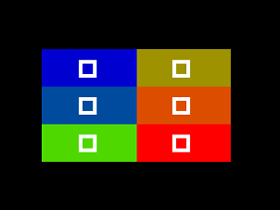
Figure: 2A
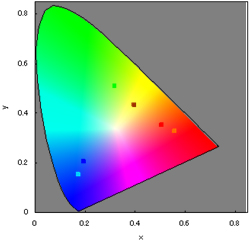
Figure: 2B
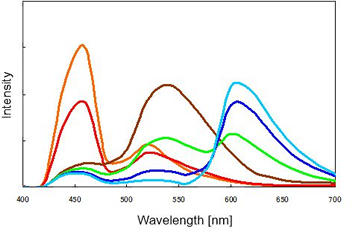
Figure: 2C
Figure 2A shows the image captured by a multispectral camera or a 2D color analyzer, taking a display which represents 6 color patches. Square shapes in Figure 2A are the areas to be measured, and chromaticity in each square shape is plotted at the chromaticity diagram (See Figure 2B). Also, regarding the multispectral camera, each spectrum distribution is shown by graph (See Figure 2C).
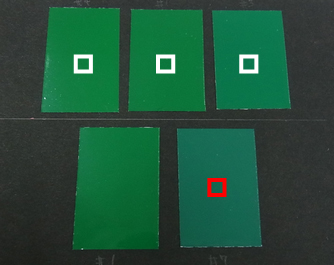
Figure: 3A
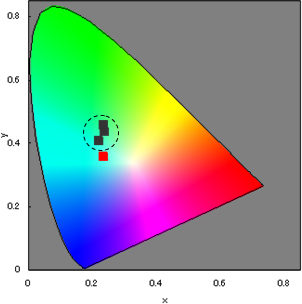
Figure: 3B
Figure 3A shows color inspections using color limit samples. Upper 3 samples are color limit samples of the object color, and under 2 samples are measuring samples. When the right measuring sample of the under 2 samples is NG, chromaticity of the NG sample is displayed as a red patch in contrast to gray patches corresponding to the chromaticity of the 3 color limit samples as shown in Figure 3B.
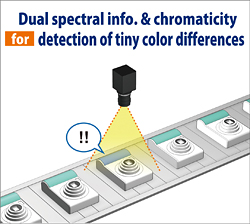
Figure 4: Color inspection usage scenario
Multiband camera
Usage scenario: state awareness
The state of a subject (freshness, purity, disease severity) can be quantitatively evaluated in ways that were not possible with previous color photography. By capturing specified spectral images of individual subjects, the sweetness of produce and the freshness of food can be quantitatively evaluated from information derived from minute differences in color.
Since the spectrum function of this camera is collected in the exclusive lens, it can respond to broad applications and used with only one camera by exchanging the exclusive lens.
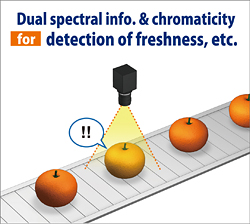
Figure 5: State awareness usage scenario
Sorted by : field “Machine Vision”